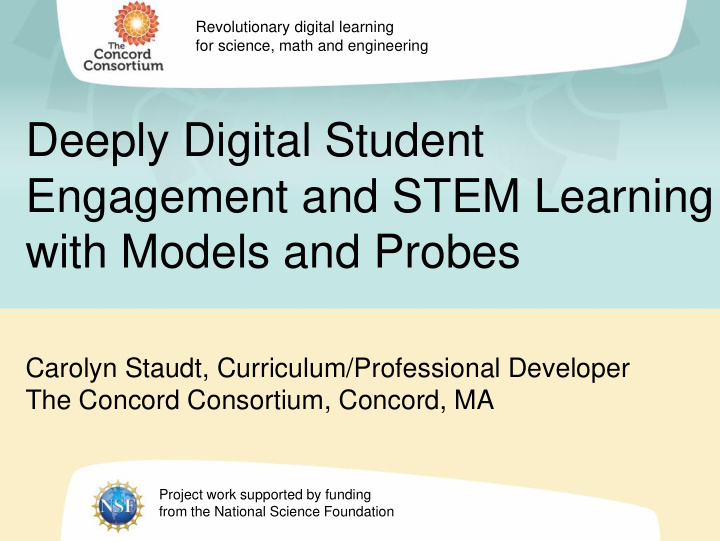



Revolutionary digital learning for science, math and engineering Deeply Digital Student Engagement and STEM Learning with Models and Probes Carolyn Staudt, Curriculum/Professional Developer The Concord Consortium, Concord, MA Project work supported by funding from the National Science Foundation
Technology’s pace today is truly astounding
STEM Activities? Empty suitcase
Abundance Activities!
Let Students Dive In! Using models and probes…
Scientific Practices (From NRC Framework for Science Education) • Asking questions / defining problems • Developing and using models • Planning and carrying out investigations • Analyzing and interpreting data • Using mathematics and computational thinking • Constructing explanations / designing solutions • Engaging in argument from evidence • Obtaining, evaluating, and communicating information
Developing and Using Models
Molecular Workbench Research • Teachers completing a professional development program and students using a series of Molecular Workbench activities embedded in courses showed statistically significant improvements in content knowledge on a Molecular Concept Inventory (MCI). • Though students had broad exposure to many topics within the courses overall, student gains on the MCI were related to the number and content of the Molecular Workbench activities they completed.
Evolution Readiness Research • Cohorts 2 and 3 had a more complex understanding of evolution than the pre- implementation Cohort 1. • Students in Cohort 2 and Cohort 3 performed statistically significantly higher on the CIER* than students in pre- implementation Cohort 1 (Effect sizes .46 and .33 SD) * Concept Inventory for Evolution Readiness
Planning & Carrying Out Investigations
Designing Solutions
Analyzing & Interpreting Data
The TEEMSS 2 curriculum was found to have potentially positive effects on general science achievement for elementary school students in grades 3 – 4. Listed as an effective curriculum in the prestigious What Works Clearinghouse.
The Problem • Graphs are central to teaching and learning in many STEM courses • However, many students, at all ages, have difficulty understanding graphs and the concepts represented in graphs SmartGraphs is designed to help students understand graphs and the concepts they represent.
Research Questions 1. What do teachers using SmartGraphs physical science activities believe about the software, including its match to important learning goals for the motion unit of study? 2. Do students who use SmartGraphs activities learn more than comparison students studying the same topic from the same textbooks, but who do not use SmartGraphs activities?
SmartGraphs Results for Q2 Pre/Post Gains Experimental Control Significance Total 5.07 4.30 p = .008 Multiple-Choice 1.16 1.07 p = .049 Open-Response 4.19 3.64 p = .043 n=1,686
Scaffolding Shading, textual hints, highlighting of points both on the graph and the
Constructing Explanations
High-Adventure Science Research • Students significantly improved their scientific argumentation ability before and after all three investigations. The improvement occurred in all four elements of scientific argumentation, i.e. claim, explanation, uncertainty rating, and uncertainty rationale. T otal effect sizes across all argumentation elements: 0.56 SD, 0.75 SD, 0.81 SD for the three investigations. • Students retained or even further improved their scientific argumentation after HAS investigations were finished.
Engaging in Argument from Evidence
Image Credits Flickr: ga3lle Sure you need a shower? Hitchcock tribute http://flickr.com/photos/3115727782 CC: by-nc-nd Flickr: Shawn Econo This Way To… http://flickr.com/photos/2235682147 CC: by-nc-sa
Thanks to our many collaborators, including: Parkland College, NANO-LINK, BIO-LINK, MATEC, OP-TEC, Center for Engineering Education and Outreach at Tufts University, the Boston Museum of Science, Purdue University, Hofstra University, Boston College, BSCS, MMSA, University of California, Berkeley, University of Toronto And above all thanks to the National Science Foundation.
facebook.com/concordcon sortium Join our Suggest a Model Contest! fbapps.concord.org/model- contest @ConcordDotOrg
Revolutionary digital learning for science, math and engineering facebook.com/concordcons ortium @ConcordDotOrg
Recommend
More recommend